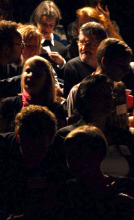There it was again: another example of a logical fallacy in the way arts institutions think about appealing to new audiences (translation — younger and more diverse audiences). Somewhere
 along the way, reaching out to new audiences was equated with new works, as if those in a museum, or in a dance company’s or orchestra’s repertoire, couldn’t possibly attract the hip young people that seem to be the holy grail of cultural organizations. In The New York Times Arts & Leisure section this weekend, writing about the 50th anniversary of Lincoln Center, Tony Tommasini exhibited a very mild version of this affliction:
along the way, reaching out to new audiences was equated with new works, as if those in a museum, or in a dance company’s or orchestra’s repertoire, couldn’t possibly attract the hip young people that seem to be the holy grail of cultural organizations. In The New York Times Arts & Leisure section this weekend, writing about the 50th anniversary of Lincoln Center, Tony Tommasini exhibited a very mild version of this affliction:
It could also be argued that the complex’s citadel-like feeling has deterred potential audiences. With its institutional appearance, Lincoln Center does not look at first glance like a place for innovative or experimental work.
We saw the same kind of “logic” earlier this year when some critics expressed disappointment that the Metropolitan Museum of Art had chosen Thomas P. Campbell — a tapestries curator, for heaven’s sake — as its new director. What could that possibly forbode, they asked, for displaying contemporary art and luring new audiences to 1000 Fifth Avenue?
To me, this is not only a fallacy…
— who says young, diverse audience always prefer new works over the old ones? — it’s also condescending, as if all work done before their time is inaccessible and/or off-putting to young people.
This is simply lazy thinking. It’s also wrong to assume that today’s young people won’t, as they age, find these “old” works appealing. (To cite one example from a previous generation, me. I remember, in my 20’s, buying tickets to the opera in San Francisco — Don Giovanni, I think it was — and disliking it. I didn’t try again until about eight years later, when I lived in London and a date took me to Salome at Covent Garden. I liked it much more, but did not become a convert until years later. Now I not only go when I can, but listen to opera at home. And I doubt that I am alone on this.)
Before a problem is solved, the issue must be framed properly. Right now, it’s not. Before jumping through hoops to attract more people — and, frequently, dumbing down their offerings as a result — cultural institutions should spend more time thinking through the problem. They’re using a simple equation — new works = new audiences — when, metaphorically, differential calculus is in order.
